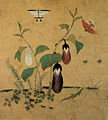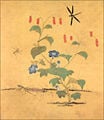Difference between revisions of "Shin Saimdang" - New World Encyclopedia
| Line 7: | Line 7: | ||
mr=Sin Saimdang| | mr=Sin Saimdang| | ||
}} | }} | ||
| − | '''Shin Saimdang''' ([[1504]]-[[1551]]) Shin Saimdang | + | '''Shin Saimdang''' ([[1504]]-[[1551]]) Shin Saimdang was a famous Joseon Dynasty (1392-1910) Korean painter and calligraphist. She was also known as Eojin Eomeoni (어진 어머니; "Wise Mother") and for over 500 years has been a model of both excellent mothering skills and a daughter of filial piety. |
| + | |||
| + | '''Family and Early Years''' | ||
| + | |||
| + | Sin Saimdang (1504-1551) was born in the village of Pukp’yong, Kangnŭng, Kangwon Province. | ||
| + | She was a descendant of the Sin family from P’yŏngsan. The P’yŏngsan Sin clan founder was General Sin Sung-gyeom. Kong Taejo of Goryeo granted Sin Sung-gyeom 300 gyul of land for his hunting skills and the clan name Pyeongsang Sin for his loyalty and bravery in battle.1 sin wiki article http://en.wikipedia.org/wiki/Shin_(Korean_name) | ||
| + | |||
| + | Saimdang’s father, Sin Myŏnghwa (1476-1522), was a scholar and had earned the “Chinsa” (presented scholar) title in 1516, but did not serve at the court of King Jungjong because of political conflicts. Saimdang's father taught her the classics and gave her the name “Saimdang” in honor of Tairen (T’aeim in Korean) the mother of King Wen of China (Western Zhou Dynasty), who was revered as a good mother and good wife. In Lenü zhuan, translated as “Biographies of Exemplary Women,” the author, Lui Xiang, mentions that Tairen was capable in “fetal instruction;” meaning that she refused foods that might disturb the fetus, and she was careful not to see or hear disturbing sights or sounds. Tairen also had blind musicians chant odes at night, much like mothers in the twenty first century play Mozart for their fetuses. By doing these things Tairen gave birth to healthy children who were gifted; superior in talent and virtue.2 Representations of Childhood and Youth in Early China. Anne Behnke Kinney. 2004 Stanford University Press pg 165 ISBN-10: 0804747318 Tairen was credited with the rise of the Zhou dynasty, because she was the mother of the founder, Wen.)3 Under Confucian Eyes: Writings on Gender in Chinese History. Susan Mann, Yi Yin Ching; editors. University of California Press pg 66 ISBN 0620-22276-8 | ||
| + | |||
| + | Saimdang’s mother was from the Yi clan of Yong’in in Kyŏnggi province that developed a base in Kangnŭng. Saimdang’s mother was the only daughter of scholar, Yi Saon. Yi Saon educated Saimdang’s mother in the classics. | ||
| + | |||
| + | Saimdang married Yi Wǒnsu (1501-1562) of the Toksu Yi clan in 1522 at the age of nineteen. Yi Won-su was a descendant of the famous naval Admiral, Yi Sun-shin. The Toksu Yi clan had established their home town in Yul-gok village, P’aju, Kyonggi Province (Yul-gok means “Chestnut Valley,” and is the pen name chosen by her son, the Confucian scholar, Yi Yi.) Yi Won-su was a scholar and governmental official. The tombs of Saimdang, Yul-gok and several family members are located in the village.4 http://nathanbauman.com/seoulhero/nfblog/?p=491 see permission email: Hi Cynthia, | ||
| + | Thank you for your email. You may certainly use my photographs of the tombs of Shin Saimdang in your online encyclopedia project—as long as you link to the page | ||
| + | http://nathanbauman.com/seoulhero/nfblog/?p=491 somewhere in the article. I'd be interested to see the finished product, by the way. Could you send me a link once it's out? | ||
| + | |||
| + | Saimdang lived with her parents at Ojukheon until the birth of her first son, Yul-gok. It was built during King Jung Jong’s reign. The house and property was named, Ojukheon, after the back bamboo that grew prolifically upon the grounds. | ||
| + | |||
| + | |||
| − | |||
| − | |||
==Gallery== | ==Gallery== | ||
Revision as of 10:29, 12 December 2007
| Shin Saimdang | ||||||||
|---|---|---|---|---|---|---|---|---|
|
Shin Saimdang (1504-1551) Shin Saimdang was a famous Joseon Dynasty (1392-1910) Korean painter and calligraphist. She was also known as Eojin Eomeoni (어진 어머니; "Wise Mother") and for over 500 years has been a model of both excellent mothering skills and a daughter of filial piety.
Family and Early Years
Sin Saimdang (1504-1551) was born in the village of Pukp’yong, Kangnŭng, Kangwon Province. She was a descendant of the Sin family from P’yŏngsan. The P’yŏngsan Sin clan founder was General Sin Sung-gyeom. Kong Taejo of Goryeo granted Sin Sung-gyeom 300 gyul of land for his hunting skills and the clan name Pyeongsang Sin for his loyalty and bravery in battle.1 sin wiki article http://en.wikipedia.org/wiki/Shin_(Korean_name)
Saimdang’s father, Sin Myŏnghwa (1476-1522), was a scholar and had earned the “Chinsa” (presented scholar) title in 1516, but did not serve at the court of King Jungjong because of political conflicts. Saimdang's father taught her the classics and gave her the name “Saimdang” in honor of Tairen (T’aeim in Korean) the mother of King Wen of China (Western Zhou Dynasty), who was revered as a good mother and good wife. In Lenü zhuan, translated as “Biographies of Exemplary Women,” the author, Lui Xiang, mentions that Tairen was capable in “fetal instruction;” meaning that she refused foods that might disturb the fetus, and she was careful not to see or hear disturbing sights or sounds. Tairen also had blind musicians chant odes at night, much like mothers in the twenty first century play Mozart for their fetuses. By doing these things Tairen gave birth to healthy children who were gifted; superior in talent and virtue.2 Representations of Childhood and Youth in Early China. Anne Behnke Kinney. 2004 Stanford University Press pg 165 ISBN-10: 0804747318 Tairen was credited with the rise of the Zhou dynasty, because she was the mother of the founder, Wen.)3 Under Confucian Eyes: Writings on Gender in Chinese History. Susan Mann, Yi Yin Ching; editors. University of California Press pg 66 ISBN 0620-22276-8
Saimdang’s mother was from the Yi clan of Yong’in in Kyŏnggi province that developed a base in Kangnŭng. Saimdang’s mother was the only daughter of scholar, Yi Saon. Yi Saon educated Saimdang’s mother in the classics.
Saimdang married Yi Wǒnsu (1501-1562) of the Toksu Yi clan in 1522 at the age of nineteen. Yi Won-su was a descendant of the famous naval Admiral, Yi Sun-shin. The Toksu Yi clan had established their home town in Yul-gok village, P’aju, Kyonggi Province (Yul-gok means “Chestnut Valley,” and is the pen name chosen by her son, the Confucian scholar, Yi Yi.) Yi Won-su was a scholar and governmental official. The tombs of Saimdang, Yul-gok and several family members are located in the village.4 http://nathanbauman.com/seoulhero/nfblog/?p=491 see permission email: Hi Cynthia, Thank you for your email. You may certainly use my photographs of the tombs of Shin Saimdang in your online encyclopedia project—as long as you link to the page http://nathanbauman.com/seoulhero/nfblog/?p=491 somewhere in the article. I'd be interested to see the finished product, by the way. Could you send me a link once it's out?
Saimdang lived with her parents at Ojukheon until the birth of her first son, Yul-gok. It was built during King Jung Jong’s reign. The house and property was named, Ojukheon, after the back bamboo that grew prolifically upon the grounds.
Gallery
See also
- List of Korea-related topics
- History of Korea
- Korean painting
Credits
New World Encyclopedia writers and editors rewrote and completed the Wikipedia article in accordance with New World Encyclopedia standards. This article abides by terms of the Creative Commons CC-by-sa 3.0 License (CC-by-sa), which may be used and disseminated with proper attribution. Credit is due under the terms of this license that can reference both the New World Encyclopedia contributors and the selfless volunteer contributors of the Wikimedia Foundation. To cite this article click here for a list of acceptable citing formats.The history of earlier contributions by wikipedians is accessible to researchers here:
The history of this article since it was imported to New World Encyclopedia:
Note: Some restrictions may apply to use of individual images which are separately licensed.



